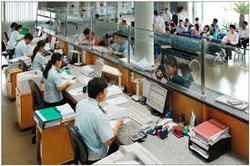Expanded e-customs procedures urged
 |
| illustration photo |
The expansion of electronic customs procedures should include special preferential businesses and the application of digital signatures in the exchange of electronic information, said Nguyen Tran Hieu, deputy head of the Department of Customs Information Technology and Statistics.
By 2015 the sector will have received information on electronic customs clearance (e-Declaration), and basic information on declaring goods and relevant documents to gradually shift to clearing customs before the arrival of goods (e-Manifest).
By then the sector will have managed and exchanged information on permits (e-Permit), electronic Certificate of Origin (e-C/O), electronic tax payment (e-Payment), and electronic office management (e-Office).
The ultimate aim is to become a customs agency that can meet demand anywhere around the clock by 2020, he said.
Customs officials by then will be able to do their job anytime and anywhere, while customs declarants can undertake and be provided with customs procedures whenever and wherever they want.
It will also lay the foundation for implementing the national and ASEAN one-stop shop mechanism, and international commitments to which Vietnam is a party, leading towards building a modern and professional customs agency, Hieu said.
E-customs enables businesses to fulfil customs procedures right at their company's office via the internet, instead of at customs agency office.
If the goods are classified in the green zone, then businesses can themselves print out customs clearance orders for delivery of goods at port.
In cases where further information is needed in the declaration process, businesses will also receive immediate online feedback from customs agencies and enter missing information on the computer.
The e-customs procedures, thanks to the application of information technology, have reduced the clearance time for imports and exports to three-15 minutes in the green zone and to 10-60 minutes in the yellow zone.
The General Department of Customs said that the introduction of e-customs procedures has considerably shortened the time to complete customs proceedings, and removed geographical and temporal distance.
It has also increased transparency, facilitated trade and aimed to attain the highest level of public service provision as classified by the Ministry of Information and Communication.
The General Department said that based on the success of applying e-customs on a trial basis in Haiphong and Ho Chi Minh City since 2005, the service has been expanded to seven other major customs departments in Dong Nai, Binh Duong, Hanoi, Danang, Lang Son, Quang Ninh, and Ba Ria-Vung Tau.
This year seven more customs departments will introduce the e-customs procedures, including Thanh Hoa, Nghe An, Thua Thien Hue, Binh Dinh, Dac Lak, Tay Ninh, and Long An.
Statistics showed that as of 2010, the department had introduced the electronic customs clearance software to 13 out of the total 33 provincial and municipal customs departments that include 70 divisions.
To support businesses, the General Department of Customs has provided free customs clearance software and published the data standard for electronic documents connected with the electronic data processing system of the customs sector.
The general department has also offered training courses to businesses.
Cao Thi Kim Lan, director of Binh Dinh Seafood Export Joint-Stock Company, said her company plans to participate in a training course in e-customs procedures after receiving a request from the provincial customs department.
"The company imports and exports a large volume of commodities every year, so applying e-customs will surely further facilitate the business operations of the company," she said.
Early this year, the General Department of Customs in co-ordination with commercial banks piloted the collection of import-export taxes electronically.
The joint efforts aim to increase the automation level in carrying out e-customs procedures and to limit the use of cash for payments, a major plan of the government.
The general department plans to expand the service to eight major customs department by the year-end, targeting to have 80 per cent of import-export revenue declaration and payments of taxes done online.
It intends this year to electronically receive and process information on commodities and means of transport prior to reaching ports.
The deputy general director of the general department, Vu Ngoc Anh, said the Customs Development Strategy until 2020 recently approved by the Prime Minister envisages the customs sector striving to have 100 per cent of customs departments and divisions in such crucial areas as seaports, airports, bordergates and key economic zones working online.
The strategy also strives to have 60 per cent of basic customs services, 70 per cent of import-export revenue, and 60 per cent of businesses applying e-customs procedures. By 2020, the percentage will have been raised to 100 per cent, 90 per cent and 80 per cent, respectively.
What the stars mean:
★ Poor ★ ★ Promising ★★★ Good ★★★★ Very good ★★★★★ Exceptional
 Tag:
Tag:
Related Contents
Latest News
More News
- EVN launches major power infrastructure projects nationwide (December 19, 2025 | 18:17)
- VAL inaugurates second production line to meet domestic animal feed demand (December 19, 2025 | 16:37)
- Sun Group pioneers urban tram system in Phu Quoc (December 19, 2025 | 15:00)
- Seven major projects launched to drive Hanoi’s next growth phase (December 19, 2025 | 14:00)
- Securing capital and efficiency for Vietnam’s 2026-2030 growth ambitions (December 17, 2025 | 10:00)
- Vietnam bucking trend in the global M&A landscape (December 16, 2025 | 14:20)
- HDS Summit spotlights Vietnam’s rising role in regional supply chains (December 16, 2025 | 08:00)
- Kolon signs $48 million airbag supply deal with Autoliv (December 15, 2025 | 18:14)
- National Assembly approves Vinh–Thanh Thuy expressway project (December 15, 2025 | 18:02)
- Quang Tri green-lights $1.59 billion LNG-fired power project (December 15, 2025 | 17:59)
























 Mobile Version
Mobile Version